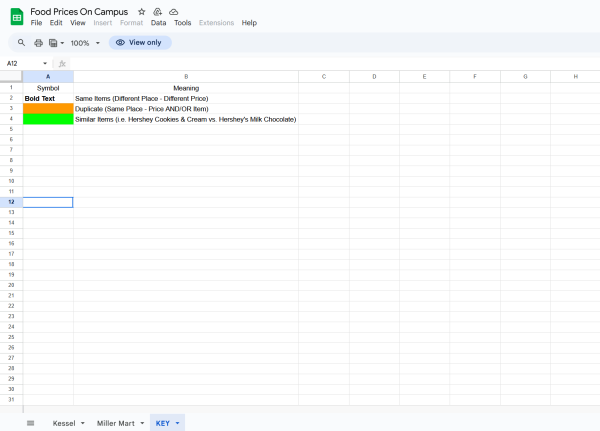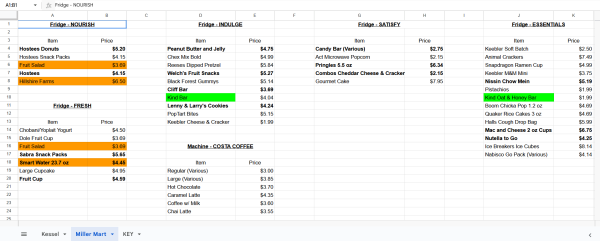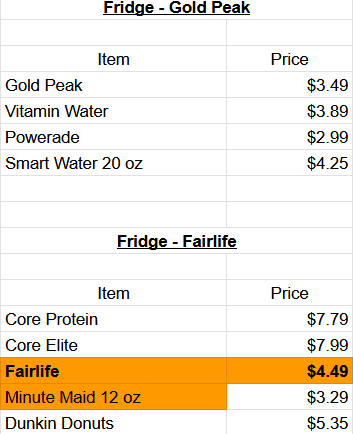Disclaimer: The information provided in the spreadsheet was examined by the writers for their prices at certain points in time and are always subject to change. The LISTED prices (meaning their amounts on a notepad or screen) were given, not what may or may not be actually charged to a student’s account as it would take longer to determine the given prices for individual, non-priced items. Regardless, one should always use their own judgement before purchasing food or drink for financial and nutrition purposes.
With all the places to spend time on campus, there’s also a bunch of places to get food on campus. The possibilities seem endless, whether it’s getting one of your three meals a day or grabbing a quick snack when hanging out with friends. Kessel Dining Hall and Miller Mart in Miller Hall exemplify this as they are located in areas with lots of social life and studying.
It’s important to distinguish between the two vendors and what forms of payment they accept. Through Kessel, one can pay via Dining Dollars, Flex Dollars, and the Meal Exchange program (the former 2 take away actual money from your account while the latter offers you a chance to get multiple items for 1 point). At Miller Mart, whatever item you choose reduces your meal account with money; this place only offers “grab-and-go” items. However, some items they serve are identical. The prices? Further research exposes potential gaps by comparing the prices of one place to another, and features testimonials from faculty and workers; the information could be found on this link, which gives the listed prices (not everything is listed).
As one can tell from the data, both Kessel and Miller Mart have a wide variety of items; some are the same, some are mutually exclusive to one. Also, not every place lists every price. For example, the Soup Station in Kessel serves soup, crackers, and oatmeal cups. Only the prices for the oatmeal (Red Mill – Gluten Free) are listed; it is $3.99 per cup. Duplicates are also listed within places even if they’re absent; for example, Miller Mart has Hillshire Farms packs listed for $6.50 in the Nourish and Hydrate fridges despite only being visibly available in the former.
Pace’s student-run businesses, PacePerk Cafe, PacePerk Mart, Pace Delivers, and Pace Fit also sell money for food and drink. Regarding the student-run businesses, Zachary Poloncarz, the Marketing Manager for PacePerk Cafe, provided some insight into why prices can be so high. He said, “inflation is a big factor for any changes in the prices at Perk. If all the places that we buy our stock from raise prices, we have to as well. Another large external factor that most people don’t know is that 20% of our revenue goes to Chartwells. And the switch in recent years from a complete dining dollar and flex meal plan to meal swipes really hurts student-run businesses.”
Chartwells, according to Clifford Mondesir – Executive Director of Pace’s Auxiliary Services, “oversees [Kessel], the Alumni Hall [Starbucks], and the Miller Byte Market. Food pricing is determined based on the types of products provided within the Dining Hall, and these prices are then compared using a Market Basket analysis against similar food service establishments in the general geographic area surrounding Pace University.” Pace uses Chartwells for events on campus, which students and faculty can order items through via budget requests for their respective organizations. While Chartwells’ prices for food are higher, often due to having large crowds at events, the availability of refreshments drives crowds to come to events in the first place. This results in outside guests saving a swipe from Kessel, which could harm their revenue too.
The meal program at Pace University is a unique one to say the least. There are incentives to save money, whether it’s using the meal exchange or going to an event with “free” food, there are trade-offs between them, Auxiliary Services, and Chartwells. Finally, Mr. Mondesir provided feedback on students’ opinions. He said, “since the implementation of the meal exchange program last academic year, we have received little to no complaints regarding food pricing or concerns relating to food insecurity among students and faculty. This positive feedback indicates that our current pricing strategies are generally well-received.” While few formal complaints have been made, the casual complaints regarding pricing occur daily, and students have the right to know if they are paying more than they should.




